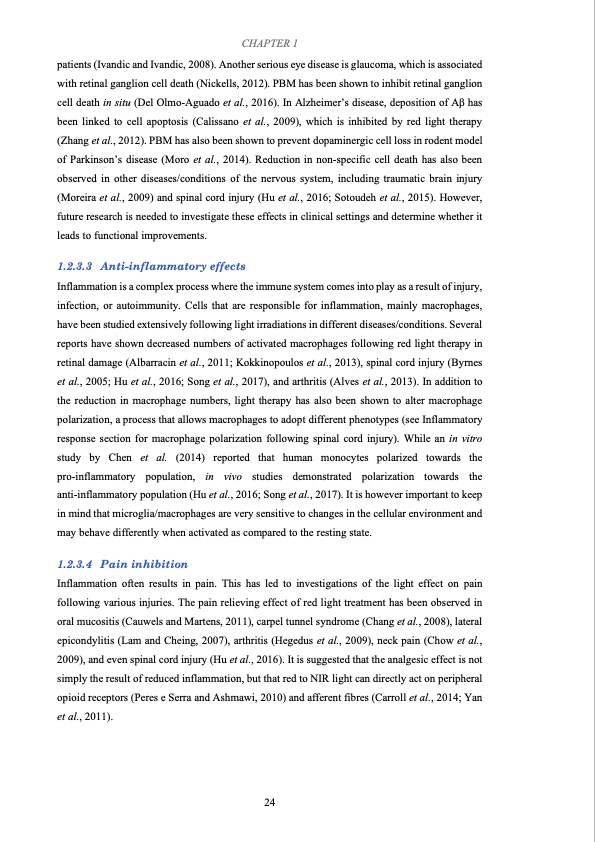
PDF Publication Title:
Text from PDF Page: 038
CHAPTER 1 patients (Ivandic and Ivandic, 2008). Another serious eye disease is glaucoma, which is associated with retinal ganglion cell death (Nickells, 2012). PBM has been shown to inhibit retinal ganglion cell death in situ (Del Olmo-Aguado et al., 2016). In Alzheimer’s disease, deposition of Aβ has been linked to cell apoptosis (Calissano et al., 2009), which is inhibited by red light therapy (Zhang et al., 2012). PBM has also been shown to prevent dopaminergic cell loss in rodent model of Parkinson’s disease (Moro et al., 2014). Reduction in non-specific cell death has also been observed in other diseases/conditions of the nervous system, including traumatic brain injury (Moreira et al., 2009) and spinal cord injury (Hu et al., 2016; Sotoudeh et al., 2015). However, future research is needed to investigate these effects in clinical settings and determine whether it leads to functional improvements. 1.2.3.3 Anti-inflammatory effects Inflammation is a complex process where the immune system comes into play as a result of injury, infection, or autoimmunity. Cells that are responsible for inflammation, mainly macrophages, have been studied extensively following light irradiations in different diseases/conditions. Several reports have shown decreased numbers of activated macrophages following red light therapy in retinal damage (Albarracin et al., 2011; Kokkinopoulos et al., 2013), spinal cord injury (Byrnes et al., 2005; Hu et al., 2016; Song et al., 2017), and arthritis (Alves et al., 2013). In addition to the reduction in macrophage numbers, light therapy has also been shown to alter macrophage polarization, a process that allows macrophages to adopt different phenotypes (see Inflammatory response section for macrophage polarization following spinal cord injury). While an in vitro study by Chen et al. (2014) reported that human monocytes polarized towards the pro-inflammatory population, in vivo studies demonstrated polarization towards the anti-inflammatory population (Hu et al., 2016; Song et al., 2017). It is however important to keep in mind that microglia/macrophages are very sensitive to changes in the cellular environment and may behave differently when activated as compared to the resting state. 1.2.3.4 Pain inhibition Inflammation often results in pain. This has led to investigations of the light effect on pain following various injuries. The pain relieving effect of red light treatment has been observed in oral mucositis (Cauwels and Martens, 2011), carpel tunnel syndrome (Chang et al., 2008), lateral epicondylitis (Lam and Cheing, 2007), arthritis (Hegedus et al., 2009), neck pain (Chow et al., 2009), and even spinal cord injury (Hu et al., 2016). It is suggested that the analgesic effect is not simply the result of reduced inflammation, but that red to NIR light can directly act on peripheral opioid receptors (Peres e Serra and Ashmawi, 2010) and afferent fibres (Carroll et al., 2014; Yan et al., 2011). 24PDF Image | Effects of Red Light Treatment on Spinal Cord Injury

PDF Search Title:
Effects of Red Light Treatment on Spinal Cord InjuryOriginal File Name Searched:
Thesis_Di Hu_final.pdfDIY PDF Search: Google It | Yahoo | Bing
Cruise Ship Reviews | Luxury Resort | Jet | Yacht | and Travel Tech More Info
Cruising Review Topics and Articles More Info
Software based on Filemaker for the travel industry More Info
The Burgenstock Resort: Reviews on CruisingReview website... More Info
Resort Reviews: World Class resorts... More Info
The Riffelalp Resort: Reviews on CruisingReview website... More Info
| CONTACT TEL: 608-238-6001 Email: greg@cruisingreview.com | RSS | AMP |